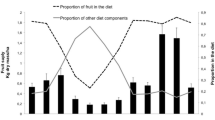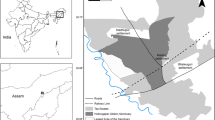Abstract
Capped langurs (Presbytis pileata) in Madhupur National Park in north-central Bangladesh have an annual diet that is comprised largely of mature leaves (42% of 20,460 total feeding records). Among colobine monkeys, only some populations of red colobus (Procolobus badius) have a diet richer in mature leaves. New leaves (11%) and fruit (24%) are the other annually important dietary items. Seasonal breakdown of this diet, however, revealed that during the monsoon months of May through September theP. pileata diet is approximately 50% fruit, including pulpy ripe fruit. This is also the period of maximum fruit availability. Data on diet and food availability indicate that while capped langurs subsist on mature leaves during the dry season (80% of diet from November to March), they select fruit and new leaves and switch to these foods whenever they are available. These data support the hypothesis that the colobine feeding strategy is adapted to cope with seasonal food scarcity.
Similar content being viewed by others
References
Altmann, J. (1974). Observational study of behavior; sampling methods.Behaviour 69: 227–267.
Bauchop, T. (1978). Digestion of leaves in vertebrate arboreal folivores. In Montgomery, G. G. (ed.),The Ecology of Arboreal Folivores, Smithsonian Institution Press, Washington, DC, pp. 193–204.
Bole, P. V., and Vaghani, Y. (1986).Field Guide to the Common Trees of India, Oxford University Press, Delhi.
Curtin, R. A. (1975).The Sociecology of the Common Langur. Presbytis entellus, in the Nepal Himalaya, Ph.D. dissertation, University of California, Berkeley.
Davies, A. G. (1984).An Ecological Study of the Red Leaf Monkey (Presbytis rubicunda) in the Dipterocarp Forest of Northern Borneo, Ph.D. dissertation, University of Cambridge, Cambridge.
Davies, A. G., Bennett, E. L., and Waterman, P. G. (1988). Food selection by two south-east Asian colobine monkeys (Presbytis rubicunda andPresbytis melalophos) in relation to plant chemistry.Biol. J. Linn. Soc., 34: 33–56.
Gautier-Hion, A. (1980). Seasonal variation of diet related to species and sex in a community ofCercopithecus monkeys.J. Anim. Ecol. 49: 237–269.
Gautier-Hion, A. (1983). Leaf consumption by monkeys in western and eastern Africa: A comparison.Afr. J. Ecol. 21: 107–113.
Gittins, S. P., and Akonda, A. W. (1982). What survives in Bangladesh?Oryz 16: 275–281.
Green, K. (1978). Primates of Bangladesh: A preliminary survey of population and habitat.Biol. Conserv. 13: 141–160.
Gurmaya, K. J. (1986). Ecology and behavior ofPresbytis thomasi in North Sumatra.Primates 27: 151–172.
Harrison, M. J. S. (1986). Feeding ecology of the black colobus, Colobus satanas, in Gabon. In Else, J. G., and Lee, P. C. (eds.),Primate Ecology and Conservation, Cambridge University Press, Cambridge, pp. 31–37.
Hladik, C. M. (1977). A comparative study of the feeding strategies of two sympatric species of leaf-monkey:Presbytis senex andPresbytis entellus. In Clutton-Brock, T. H. (ed.),Primate Ecology, Academic Press, London, pp. 324–353.
Hladik, C. M. (1978). Adaptive strategies of primates in relation to leaf-eating. In Montgomery, G. G. (ed.),The Ecology of Arboreal Folivores, Smithsonian Institution Press, Washington, DC, pp. 373–395.
Islam, M. A., and Hussein, K. Z. (1982). A preliminary study on the ecology of the capped langur.Folia Primatol 39: 145–159.
McKey, D. B., and Waterman, P. G. (1982). Ranging behaviour of a group of black colobus (Colobus satanas) in the Douala-Edea Reserve, Cameroon.Folia Primatol. 39: 264–304.
Milton, K. (1979). Factors influencing leaf choice by howler monkeys: A test of some hypotheses of food selection by generalist herbivores.Am. Nat. 114: 362–378.
Milton, K. (1980).The Foraging Strategy of Howler Monkeys, Columbia University Press, New York.
Mueller-Dombois, D., and Ellenberg, H. (1974).Aims and Methods of Vegetation Ecology, Wiley and Sons, New York.
Napier, J. R., and Napier, P. H. (1967).A Handbook of Living Primates, Academic Press, New York.
Newton, P. N. (1985). The behavioural ecology of forest Hanuman langurs.Tigerpaper 12: 3–7.
Oates, J. F. (1977). The guereza and its food. In Clutton-Brock, T. H. (ed.),Primate Ecology, Academic Press, London, pp. 276–321.
Oates, J. F. (1988). The diet of the olive colobus monkey,Procolobus verus, in Sierra Leone.Int. J. Primatol. 9: 457–478.
Oates, J. F., Waterman, P. G., and Choo, G. M. (1980). Food selection by the south Indian leaf-monkey,Presbytis johnii, in relation to leaf chemistry.Oecologia 45: 45–56.
Oates, J. F., Whitesides, G. H., Davies, A. G., Waterman, P. G., Green, S. M., DaSilva, G. L., and Mole, S. (1990). Determinants of variation in tropical forest primate biomass: New evidence from West Africa.Ecology 71: 328–343.
Pocock, R. I. (1928). The langurs, or leaf-monkeys, of British India.J. Bombay Nat. Hist. Soc. 32: 660–677.
Puri, G. S. (1960).Indian Forest Ecology, Vol. I and II. New Delhi, Oxford Books.
Stanford, C. B. (1991a). Social dynamics of intergroup encounters in the capped langur (Presbytis pileata) in Bangladesh.Am. J. Primatol. (in press).
Stanford, C. B. (1991b). The capped langur in Bangladesh: Behavioral ecology and reproductive tactics,Contributions to Primatology, Karger, Basel (in press).
Struhsaker, T. T. (1975)The Red Colobus Monkey, University of Chicago Press, Chicago.
Sugiyama, Y. (1976). Characteristics of the ecology of the Himalayan langurs.J. Hum. Evol. 5: 249–277.
Waterman, P. G. (1984). Food acquisition and processing by primates as a function of plant chemistry. In Chivers, D. J., Wood, B. A., and Bilsborough, A. (eds.),Food Acquisition and Processing by Primates, Plenum Press, New York, pp. 177–211.
Waterman, P. G., and Choo, G. M. (1981). The effects of digestibility reducing compounds in leaves on food selection by some Colobinae.Malaysian Appl. Biol. 10: 147–162.
Waterman, P. G., Ross, J. A. M., Bennett, E. L., and Davies, A. G. (1988). A comparison of the floristics and leaf chemistry of the tree flora in two Malaysian rain forests and the influence of leaf chemistry on populations of colobine monkeys in the Old World.Biol. J. Linn. Soc. 34: 1–32.
Yeager, C. P. (1989). Feeding ecology of the proboscis monkey (Nasalis larvatus).Int. J. Primatol. 10: 497–530.
Author information
Authors and Affiliations
Rights and permissions
About this article
Cite this article
Stanford, C.B. The diet of the capped langur (Presbytis pileata) in a moist deciduous forest in Bangladesh. International Journal of Primatology 12, 199–216 (1991). https://doi.org/10.1007/BF02547584
Received:
Revised:
Issue Date:
DOI: https://doi.org/10.1007/BF02547584




